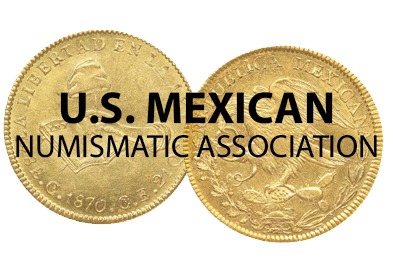El Banco de Nuevo León
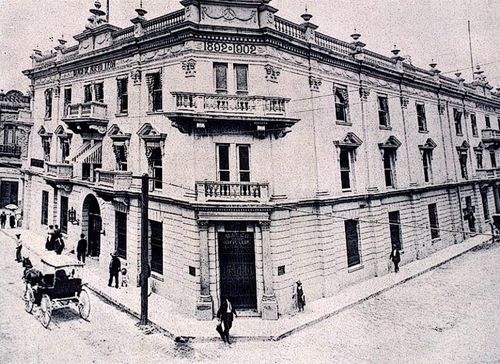
On 5 August 1891 the Secretario de Hacienda agreed a contract with Francisco Olivares and Manuel Peniche, representing a group of local investorsthe most prominent were Evaristo Madero who contributed $260,000, Marcelino Garza ($50,000), General Gerónimo Treviño ($30,000), Rómulo Larralde ($25,000) and Viviano L. Villarreal ($24,000), to establish a bank of issue in Monterrey with a capital of $600,000 and the right to set up branches in Nuevo León, Coahuila and Tamaulipas. The bank began operations on 1 October 1892 at 17 calle del Comercio (today Morelos). It opened 18 branches in Tampico, Ciudad Victoria, Laredo, Sierra Mojada, Matamoros, Ciudad Porfirio Díaz (today Piedras Negras), Monclova, Torreon and Cuatro Ciénegas.
The initial share capital of $600,000 was increased to $960,000 in February 1889, to $1,200,000 in March 1900 and to $2,000,000 in July 1902.
As a consequence of the Ley General de Instituciones de Crédito of 1897 the bank entered into a new concession, which was approved by Congress on 22 November 1897.
The bank paid very good dividends to its shareholders: 12% in 1897 and 15% each year from 1899 through to 1911, with one exception, 14% in 1905.
At the end of 1910 the Dirección General de Correos ordered its offices not to accept notes of the Banco de Nuevo León. This naturally caused alarm and in the beginning of 1911 the bank was presented with large quantities of notes that holders wanted redeemed in coin (the value of notes in circulation dropped from $2,345,632 in December 1910 to $1,793,441 in January 1911). The board held extraordinary meetings and managed to get the order revoked and issued circulars[text needed] to reassure the public. It also had the support of the Banco Central Mexicano, and the local branches of the Banco Nacional de México and the Banco de Londres, banking houses and businesses put out notices that they would accept the Banco de Nuevo León notes at parEl Tiempo, 7 September 1911, informe of board to AGM, 27 August 1911.
On 15 September 1916, Carranza issued his decree ordering the banks to comply with the 1897 Ley General. On 3 October Rafael Herrera y Lasso presented his credentials as Inspector of Credit Institutions to Rodolfo M. Garza and consequently also as Interventor for the bank. Following an audit Garza wrote to Carranza reminding him of the 24 year old record of honesty and absence of negative antecedents or observations by the Secretaría de Hacienda. He added that the bank’s concession stated that any disagreement should be referred to the courts, and also that the banks were required to redeem their issues in metal coin, while the Constitutionalists were not so required, which devalued the bank’s assets.
On 8 January 1917 Genaro González, Daniel Zamarripa and Alfredo Lozano Saldaña appeared before Garza as representatives of the Confiscation Committee (consejo de incaudación) appointed by the Secretaría de Hacienda. Garza asked for a postponement of the process in order to call a meeting of the Board and telegraph the Secretaría de Hacienda seeking a reprieve. Between 9 and 21 January numberless telegrams were sent and received by Garza and by the Confiscation Committee headed by Genaro González. On 30 January. Caledonio Junco de la Vega left for Mexico City to negotiate the situation. He and Garza held a meeting on 19 February but nothing was settled. The bank cashier Amador Paz and the contador Arturo Manrique were pressed to sign the Confiscation Document together with Genaro González, but they refused. Thus, the weeks went without the Confiscation Committee fulfilling its task.
Meanwhile, the bank proceeded to change its reserves for US gold. Word soon got to the Confiscation Committee. On 4 May 1917 they presented a telegram from the Secretaría de Hacienda requesting a forced loan of 150,000 US Dollars The bank declined to comply because only the manager or the Board were permitted to withdraw such amount from the bank. The manager was away and could not issue instructions and the Board could not gather all its members. The Confiscation Committee then ordered the bank employees to submit since they had express orders to indemnify them after their dismissal. Even this could not alter the bank employees’ fidelity. An appeal was made to the Military Commander and Governor General Alfredo Ricaut and on 29 May Paz and Manrique were summoned to the Government Palace where General Ricaut compelled them to obey. They informed the governor that the Confiscation Committee had never presented any written terms to the bank having to do with confiscation. On 1 June the members of the committee showed up with a written order, but it was rejected by the bank employees arguing that the terms were so vague that the Banco de Nuevo León was not even mentioned. Later that afternoon the Confiscation Committee again showed up, headed by Genaro González, and met with. Paz and Manrique, accompanied by Lazaro de la Garza, as legal representative of the bank. This time the Committee had with them a formal document for the confiscation of the Banco de Nuevo León. The Confiscation Committee sealed the bank vaults and dismissed the employees. It was arranged that the bank building was to be under the surveillance of the police, forbidding entry to anyone.
Under Obregón's decree of 31 January 1921 the bank was placed into Class A (for banks whose assets were greater than their liabilities) and allowed to resume all customary operations except the issue of bank notes. The bank was finally liquidated in 1930.
American Bank Note Company print runs
Antonio V. Hernández was commissioned by the board to contact the American Bank Note Company regarding the printing of notes The board determined to issue notes of $1, $2, $5, $10, $20, $50, $100 and $500, up to the stipulated maximum of $1,800,000, though in fact the $2 note was never produced. Hernández left for New York on 30 April 1892 and returned on 11 June.
The American Bank Note Company engraved special vignettes of Ignacio Zaragoza (C 198)General Ignacio Zaragoza was born in 1829 in Bahia de Espiritu Santo, Texas and died of typhoid fever in 1862. Liberal from the beginning, he fought against Santa Anna and Comonfort in defence of the Constitution of 1857 and the reform principals. Later he fought against the French, defeating and humiliating them at Fort Loreto, Puebla. While he did not live long enough to see the ultimate victory over the French, he was considered one of Mexico’s great heroes., the arms of Monterrey (C 477), a view of Monterrey (C476) and of the Santa Catarina river and Cerro de la Silla (C 475).
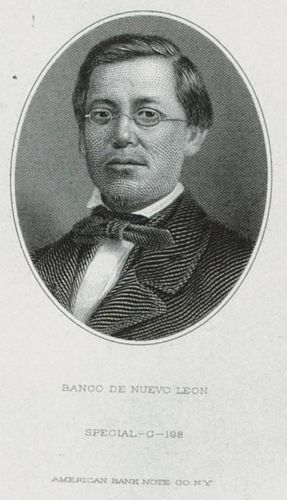
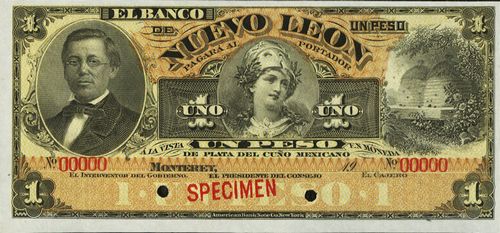
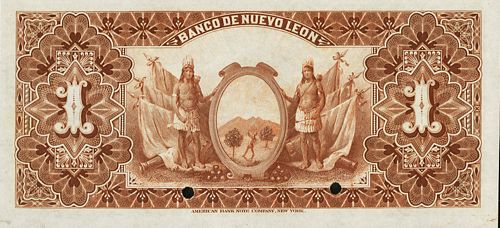
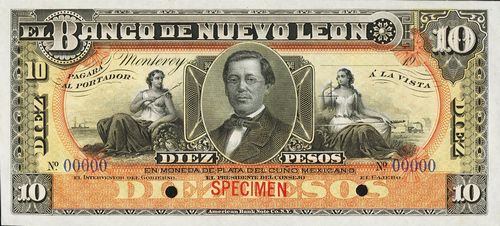
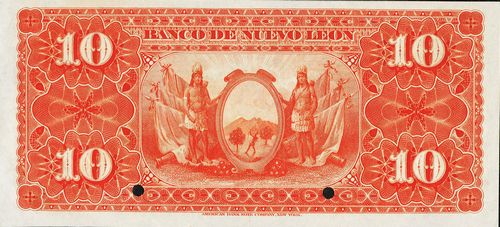
| Date | Value | Number | Series | from | to |
| June 1892 | $1 | 50,000 | 00001 | 50000 | |
| $5 | 20,000 | 00001 | 20000 | ||
| $10 | 20,000 | 00001 | 20000 | ||
| $20 | 10,000 | 00001 | 10000 | ||
| $50 | 3,000 | 00001 | 3000 | ||
| $100 | 1,500 | 0001 | 1500 | ||
| $500 | 100 | 1 | 100 |
| Date | Value | Number | Series | from | to |
| March 1894 | $5 | 20,000 | 20001 | 40000 | |
| $10 | 10,000 | 20001 | 30000 | ||
| $20 | 5,000 | 10001 | 15000 | ||
| $50 | 4,000 | 3001 | 7000 | ||
| $100 | 2,500 | 1501 | 4000 | ||
| $500 | 300 | 101 | 400 |
For the next printing the title "EL CAJERO" was changed to "EL GERENTE".
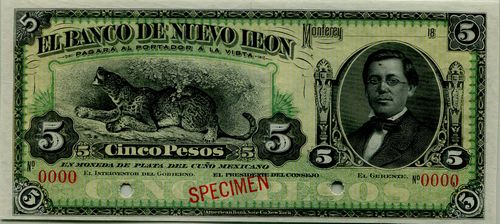
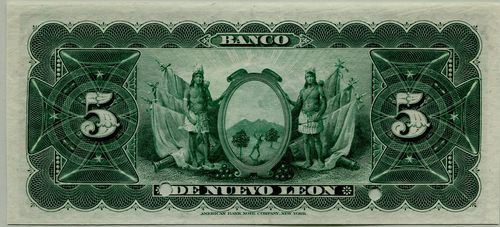
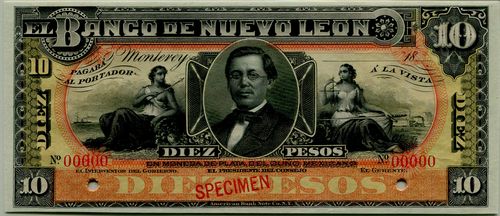
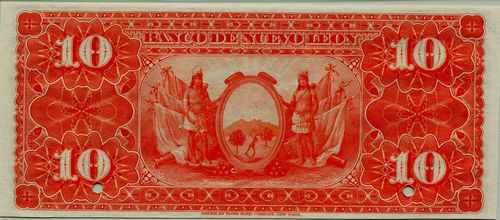
| Date | Value | Number | Series | from | to |
| May 1899 | $5 | 80,000 | 40001 | 120000 | |
| $10 | 30,000 | 30001 | 60000 | ||
| $20 | 10,000 | 15001 | 25000 | ||
| $50 | 2,000 | 7001 | 9000 | ||
| $100 | 2,000 | 4001 | 6000 | ||
| $500 | 600 | 401 | 1000 |
For the next printing the dateline "Monterrey ______18__" was changed to "Monterrey ______19__" .
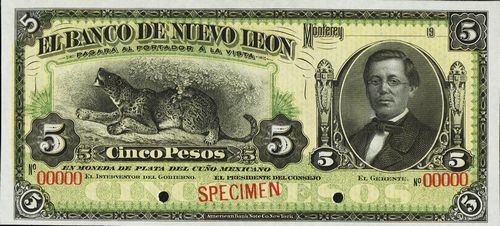
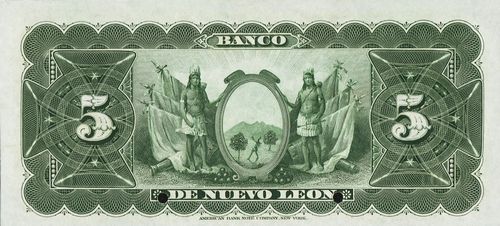
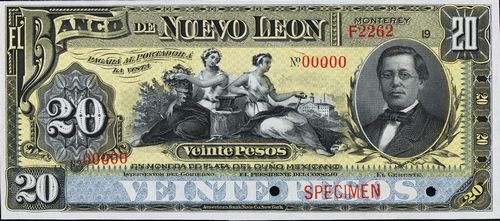
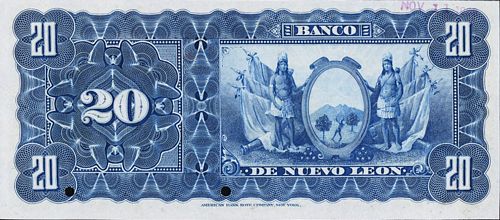
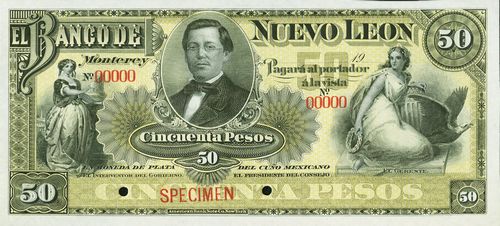
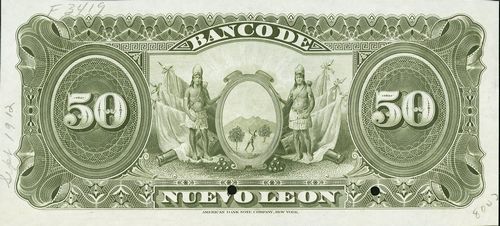
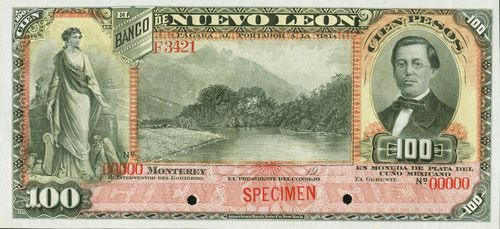
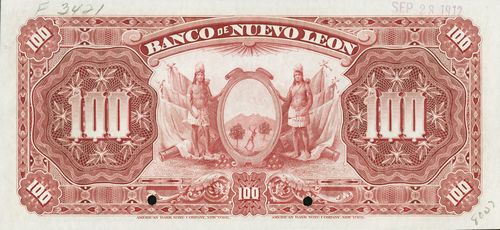
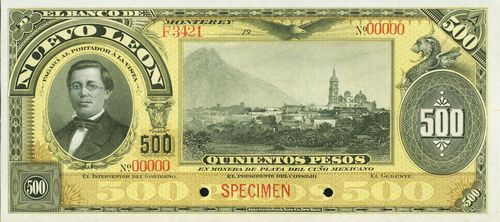
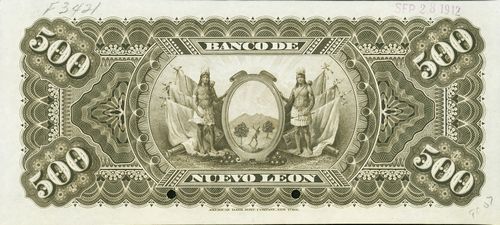
| Date | Value | Number | Series | from | to |
| December 1902 | $5 | 120,000 | 120001 | 240000 | |
| $10 | 60,000 | 60001 | 120000 | ||
| $20 | 20,000 | 25001 | 45000 | ||
| $50 | 4,000 | 9001 | 13000 | ||
| $100 | 2,000 | 6001 | 8000 |
On 19 October 1909 the bank asked the ABNC for the price of 105,040 notes, totalling $1,500,000, in six denominations, but on a better class of paper then used before, as their previous notes had always been easily damaged, and they desired to have a more resistant quality of paperABNC, folder 195, Banco de Nuevo León (1907-1927). On 28 October the ABNC replied with a price ($3,321.75 U.S. Gold, F.O.B. New York) but said that, with regards to the paper, they had only one kind for banknote work, but in two weights of this paper, (J.M.25 and J.M.27), of which they enclosed specimens. The bank chose J.M. 25, though the ABNC thought that the two specimens of paper had been wrongly markedibid..
The bank ordered the notes on 3 November, and sent the serial numbering required on 10 December. On 3 January 1910 it asked, if there was still time, to alter EL CAJERO to EL GERENTE or, if the notes had already been printed, to cross out EL CAJERO and print EL GERENTE instead. On 10 January the ABNC replied that, even before receiving the bank’s request, it had anticipated it in accordance with their previous order. The only plate that did not have the said change was the $10, and this had now been done.
| Date | Value | Number | Series | from | to |
| November 1909 | $5 | 64,000 | 240001 | 304000 | |
| $10 | 24,000 | 120001 | 144000 | ||
| $20 | 7,500 | 45001 | 52500 | ||
| $50 | 6,000 | 13001 | 19000 | ||
| $100 | 3,200 | 8001 | 11200 | ||
| $500 | 340 | 1001 | 1340 |
On 15 March the ABNC forwarded, via Wells Fargo Express, a box, containing 35,000 $5 (240001-275000), 7,500 $10 (120001-127500) and 340 $500 (1001-1340) and these were received in Monterrey by 1 April. On 4 April a box containing 29,000 $5 (275001-304000), 15,500 $10 (127501-144000), 7,500 $20 (45001-52500), 6,000 $50 (13001-19000) and 3,200 $100 (8001-11200) completed the order.
On 10 September 1912 the bank again asked the ABNC for prices and on 24 September ordered the same quantity of notes as the previous order, but this time on J.M. 27 paper.
| Date | Value | Number | Series | from | to |
| September 1912 | $5 | 64,000 | 304001 | 368000 | |
| $10 | 24,000 | 144001 | 168000 | ||
| $20 | 7,500 | 52501 | 60000 | ||
| $50 | 6,000 | 19001 | 25000 | ||
| $100 | 3,200 | 11201 | 14400 | ||
| $500 | 340 | 1341 | 1680 |
This whole order was forwarded by Wells Fargo Express on 29 March 1913. On 5 April R. M. Garza, the bank’s manager, asked the ABNC to request the Wells Fargo Express agent in New York to give instructions to have the cases sent via Brownsville, as traffic via Laredo had been cut off for some time, and it did not seem as if it would be resumed very soon. Then, on 19 April the bank cabled “kindly hold shipment at the frontier returning cases of bank notes to New York. Await further instructions.”, because communication to Monterey from Laredo and Matamoros had been cut of. The ABNC decided it would be wiser to hold the cases at Laredo, but on 15 May asked the bank whether they should be returned to New York and shipped via Veracruz. The same day the bank told the ABNC to wire the Express office at Laredo to deliver the cases to the Milmo National Bank (in Laredo).
When Huerta allowed banks to issue $1 and $2 notes, on 25 November the bank wrote that it wished to make an issue of $1 notes, using the existing plates. On 2 December the ABNC gave their price and reported that the plates were in good condition and could be used, changing the dateline to read:- “Monterey----------------------------19—". On 16 December the bank asked that “EL CAJERO” should also be changed to “EL GERENTE” but the ABNC misread this, so the notes bore the title “EL CAJERO”.
| Date | Value | Number | Series | from | to |
| December 1913 | $1 | 50,000 | 50001 | 100000 |
The ABNC forwarded the 50,000 notes (50001-100000) by Wells Fargo Express, per the steamer “Monterey” via Veracruz, to the Banco Central Mexicano, on 22 January 1914.
On 8 April 1914 the bank wrote that it wished to make a new issue of 200,000 50c and 50,000 $1 notes. The 50c note would be a new issue so the bank gave the following instructions: “The $1 notes should be exactly the same as those which you recently sent us, taking care that the titles should appear in this manner:- “Interventor del Gobierno” “Presidente del Consejo” “Gerente.” These titles shall also appear in this manner on the 50 centavos notes, selecting for these a color entirely different from any heretofore used on notes issued by us – with which you are familiar. The selection of color is left entirely to your good taste.
Instead of the 50 centavos notes carrying the number “50” in the two upper corners on the back, we would like to have the face and back shown of one of our coins of this denomination, and enclose one herewith as model; that is, we would like to have the eagle in one corner and in the other the “50” with all the emblems as shown on the coin. As regards the face of this note – it should be printed the same as the others, or say, to carry the figure “50” in the same place as the figure $1 is shown on the notes of that denomination. The size of the notes is to be exactly the same as the $1 value. We believe that with these explanations you will get a clear idea of what we want and would thank you to repeat the same when replying so as to make sure that you have correctly interpreted our order. In case of any misunderstanding we will make the same clear to you in due time, so that the final work should remain as it should be.”
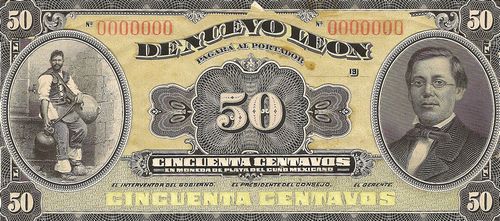
The ABNC prepared models for the 50c note and sent them to Mexico City but on 2 July Charles Blackmore, their Resident Agent, returned them, as he had been unable to communicate with the bank as there was no direct communication between Mexico City and Monterrey. He suggested trying to contact them via Laredo or with the Provisional Agency of the bank in Brownsville.
| Date | Value | Number | Series | from | to |
| May 1914 | $1 | 50,000 | 100001 | 150000 |
On 22 July the ABNC told the bank that the $1 notes were ready and asked for shipping instructions, but the next day, the bank replied that it had not ordered any notes. The ABC had to acknowledge that it had misunderstood the bank’s original letter, though in its own defence. on 23 July, it wrote:
“During some months past, realizing the special conditions prevalent in Mexico and the fact that our good friends and customers, the various Mexican Banks, found themselves in an exceptional position which caused them a most urgent and pressing need for immediate supplies of paper money, we, on our side, have done everything humanly possible to supply the wants of our good friends, the various Banks in Mexico, in the shortest possible time. In looking back over the history of the past few months it is our belief that we have made and delivered bank notes to our Mexican friends in less time than similar quality of work has ever been done by us or by anyone. This highly satisfactory result to us, and we trust to our friends, was only achieved by most earnest and unremitting efforts on our part, and we were only able to achieve this result by preceding with work with absolutely no delay whatsoever.
Therefore, when we received your esteemed favor of April 6th, believing that you wished to give us a firm order for the one Peso notes, we without a moments delay, immediately put this work in hand and pushed it along at utmost speed. In doing this we thought and believed that we were acting to your best interests, in order to be able to furnish you with these notes at the earliest possible moment. It is now with great regret that we learn of our misunderstanding of your desire in this matter, a mistake which, we trust, will cause you no inconvenience.
In accordance with the suggestion contained in your favor of July 23rd, we will hold these notes ready for immediate shipment to you whenever you so desire. The notes will be deposited in our vaults so that they will be absolutely safe.”
On 29 July the bank, at Monterey, received the design for the 50c note, which it found entirely satisfactory, though it suggested showing the word “CENTAVOS” next to the two figures 50, so as to avoid any confusion with their $50 notes. However, they wrote “it is absolutely necessary for us to postpone the order relative to these notes, due to the fact that we do not know what resolutions will be adopted by the new Government in this country, as the issue of said notes was approved by official arrangement of the outgoing government, and it might be that the new regime would not approve of the act emanating from the previous administration; it would therefore be perfectly useless for us to hold notes of that denomination. In view of this we would ask you to suspend the work until we can make some final decision regarding the matter and allow us to hold the respective design, unless you wish us to return it to you.”
After an enquiry, on 3 September 1924 the bank agreed as none of the old banks of issue could any longer issue notes it would be best to dispose of the 50,000 $1 notes and on 24 October 1924 they were cremated.
In April 1925 the San Antonio Express reported the destruction of certain obsolete Mexican banknotesSan Antonio Express,[ ] April 1925 (ABNC, folder 179, Banco Mercantil de Monterey (1909-1933)).
$1,500,000 Goes Up in Smoke
What would have been $1,500,000 in Mexican currency, had the notes been signed and issued in the regular way, was burned in the basement of the Texas State Bank & Trust Company of Thursday morning.
In 1913, the currency was ordered by the Bank of Monterrey from the American Bank Note Company of New York. The shipment was intercepted at Laredo and ordered held pending outcome of revolutionary activities. It has been held in this country ever since.
Since the currency was printed, the laws of Mexico have been changed, and now currency can be issued only by the Bank of Mexico. Formerly, State and National banks were permitted to issue currency in much the same manner as American banks.
The Bank of Mexico has ordered the currency printed for the Bank of Monterrey destroyed.
Arturo Manrique, sub-manager of the Bank of Monterrey, was sent here to witness destruction of the paper. Although it is without actual value, laws of his government require affidavits of witnesses.
The picture above shows the janitor in the basement of the San Antonio bank shoveling the paper into the furnace, while H. M. Compton, vice-president of the bank, Mr. Manrique (wearing the straw hat) and A. Martinez, San Antonio attorney, look on.
These were obviously the shipment which was last heard of in 1913 at the Milmo National Bank in Laredo, as that consigment consisted of $1,500,000 in notes.
The plates used in engraving the notesThe plates were:
1 – 6 on 1 Peso face plate #2 made on order No. F 4198
1 – 6 on 1 Peso back plate made on order of 1 July 1892
2 – 1 on 1 Pesos tints 1 & 2 made on order of 1 July 1892
1 – 4 on 5 Pesos face plate No. 4 made on order No. F 2262
1 – 4 on 5 Pesos face plate No. 5 made on order No. F 3419
1 – 4 on 5 Pesos back plate # 4 made on order No. F 3419
2 – 1 on 5 Pesos tints 1 & 2 made on order of 1 July 1892
1 – 4 on 10 Pesos face plate #3 made on order No. F 2262
1 – 4 on 10 Pesos back plate made on order of 1 July 1892
2 – 1 on 10 Pesos tints 1 & 2 made on order of 1 July 1892
1 – 2 on 20 Pesos face plate made on order of 1 July 1892
1 – 2 on 20 Pesos back plate #2 made on order No. F 3420
2 – 1 on 20 Pesos tints 1 & 2 made on order of 1 July 1892
1 – 4 on 50 Pesos face plate made on order No. F 2262
1 – 4 on 50 Pesos back plate made on order No. F 2262
1 – 1 on 50 pesos face plate made on order No. F 2262
1 – 1 on 50 pesos back plate made on order No. F 2262
2 – 1 on 50 Pesos tints 1 & 2 made on order of 1 July 1892
1 – 1 on 100 pesos face plate made on order of 1 July 1892
1 – 1 on 100 pesos back plate made on order of 1 July 1892
2 – 1 on 100 Pesos tints 1 & 2 made on order of 1 July 1892
1 – 1 on 500 pesos face plate made on order of 1 July 1892
1 – 1 on 500 pesos back plate made on order of 1 July 1892
2 – 1 on 500 Pesos tints 1 & 2 made on order of 1 July 1892 were cancelled on 7 October 1931.
